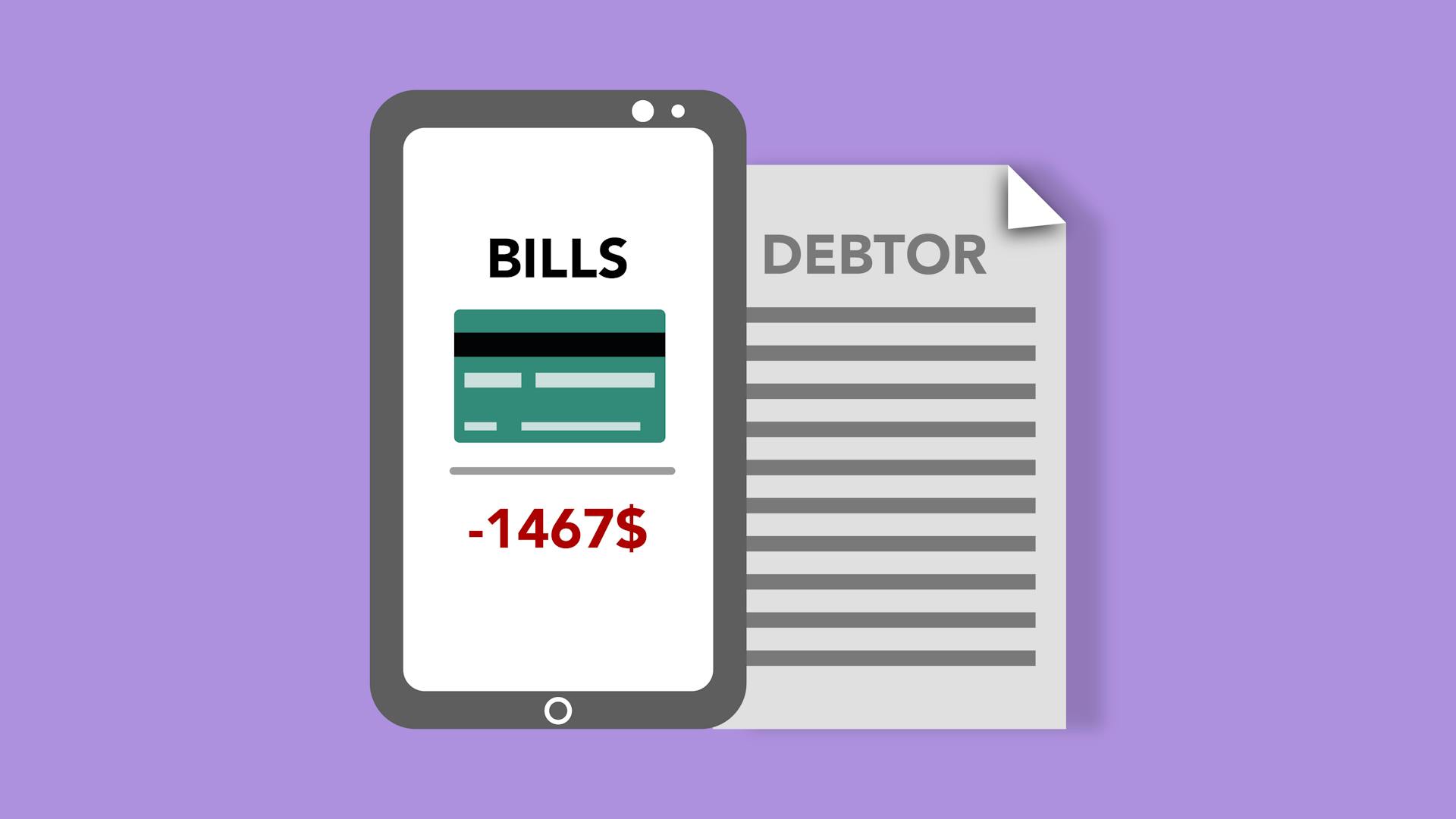
Understanding predatory lending is crucial for protecting your finances, and it's essential to know the warning signs. Predatory lenders often target vulnerable individuals with high-interest loans, charging exorbitant rates that can lead to debt spirals.
Predatory lending can take many forms, including payday loans, title loans, and rent-to-own schemes. These types of loans often have hidden fees and charges that can quickly add up. In some cases, lenders may even use deceitful tactics to convince borrowers to take on more debt than they can afford.
The consequences of predatory lending can be severe, including bankruptcy, damaged credit scores, and even homelessness. In fact, a study found that nearly 75% of payday loan borrowers experience financial difficulties within two weeks of taking out a loan.
Additional reading: Predatory Lending Student Loans
Tactics to Watch Out For
Predatory lenders use various tactics to take advantage of borrowers. Excessive and abusive fees are common, often disguised or downplayed as part of the loan's interest rate. According to the FDIC, fees totaling more than 5% of the loan amount are not uncommon.
Consider reading: Predatory Car Loan Lawsuit
Balloon payments can be used to make monthly payments look low, but the substantial payment at the end of the loan's term may be unaffordable. This can lead to refinancing, new costs, or default.
Loan flipping involves pressuring a borrower to refinance repeatedly, generating fees and points for the lender each time. This can trap a borrower in an escalating debt burden.
Asset-based lending and equity stripping use a borrower's asset, such as a home or car, rather than their ability to repay the loan. This can result in losing the asset when payments are missed.
Unnecessary add-on products or services, like single-premium life insurance for a mortgage, can be used to increase profits.
Steering involves lenders pushing borrowers into expensive subprime loans, even when they qualify for prime loans.
Reverse redlining targets Black and Latinx communities in neighborhoods that were previously redlined, making them more vulnerable to predatory lending.
Here are some specific tactics to watch out for:
- Excessive prepayment penalties
- Fees that serve no real purpose other than to make more money off borrowers
- Vague-sounding items on your loan estimate, like "administrative fees"
- Inflated fees and charges, such as appraisals, closing costs, and document preparation fees
- Unlicensed loan officers
- Promises of a loan regardless of credit history
- Being rushed to sign papers without fully understanding the terms
- High interest rates and fees, such as rates higher than 30%
- Blank spaces in documents that can be filled in with unreasonably high interest rates or other unfavorable terms.
Types of Predatory Loans
Predatory loans come in many forms, each designed to trap borrowers in a cycle of debt. Loan churning is one such tactic, where a lender makes a loan the borrower can't afford, and when the debt isn't paid, offers a new loan with more fees.
Subprime loans have been particularly problematic, leading to the 2008 economic collapse, and have now resurfaced in the auto loan market, where rates can reach as high as 22% for a used car loan.
Payday loans are another type of predatory loan, with annual percentage rates (APR) ranging from 390% to 780% and typically lasting only 30 days or less. Many borrowers end up refinancing these loans, adding new fees and spiraling out of control.
Discover more: Predatory Lending Interest Rates Are Capped at
New Forms
In the gig economy, new schemes are popping up that can be detrimental to consumers. Uber agreed to a $20 million settlement with the Federal Trade Commission (FTC) in 2017, in part for auto loans with questionable credit terms that the platform extended to its drivers.
Buy now, pay later products are another form of predatory lending. These products are not always clear about fees and interest rates and may entice consumers to fall into a debt spiral they will not be able to escape.
Fintech firms are launching these products at an alarming rate. Research suggests that the market for payday loans has only expanded since 2008 and that it enjoyed a boom during the 2020–2022 COVID-19 pandemic.
These products often have extremely high interest rates, with APRs ranging from 390% to 780%. Payday lenders operate online and through storefronts largely in financially underserved—and disproportionately Black and Latinx—neighborhoods.
Borrowers often can’t pay, so the loan is refinanced and the debt spirals. Payday lenders usually operate out of storefront offices in low-income neighborhoods.
These products are not only predatory but also create a cycle of debt that is difficult to escape. A 2019 study found that using payday loans doubles the rate of personal bankruptcy.
See what others are reading: Fire Escape Important
Asset Based
Asset Based Lending is a type of predatory loan that's based on the value of your assets, rather than your income or ability to repay. This can lead to borrowers taking on more debt than they can handle.
You can end up borrowing more than you should on a refinance loan based on your home equity, as seen in Asset Based Lending. This can be a recipe for financial disaster.
Subprime mortgage lending, which led to the 2008 economic collapse, also relied on asset values rather than borrower ability to repay. This type of lending can have devastating consequences for individuals and families.
Auto-Title Loans, which require you to hand over your vehicle's title and a spare set of keys as collateral, also use asset values to determine loan amounts. If you can't repay the loan, the lender takes your vehicle.
Check this out: Vehicle Inspected
Types of Predatory Loans
A balloon payment is a lump-sum mortgage payment that's usually charged after a certain period. It's often accompanied by low interest rates and low payments upfront, but can lead to financial trouble when the large payment is due.
You might start with a loan that has a low interest rate and low payments, but get hit with a balloon payment for a large amount. This can be a recipe for disaster if you can't pay it, and you could even lose your home.
In some cases, a predatory lender will offer to refinance the loan into a new mortgage with a fixed interest rate. However, this process would involve more fees pocketed by the lender, who put you in the situation in the first place.
Negative Amortization
Negative amortization is a sneaky way predatory lenders can take advantage of you. They'll offer a loan with a monthly payment that's too small to cover even the interest, which gets added to the unpaid balance.
This can result in a borrower owing substantially more than the original amount borrowed. It's like digging a hole and then being asked to fill it with more dirt.
The lender should provide you with an amortization schedule that shows how much of the interest and principal balance you're paying off throughout your loan term. But if they don't, you might not even know you're being taken advantage of.
If you're not careful, negative amortization can lead to a balloon payment for a large amount, which can be devastating if you can't pay it.
Credit Menu
If you're struggling with debt or credit issues, it's essential to know your rights and options. You can start by understanding your credit reports and scores, which can be affected by credit fluctuations.
Credit counseling is a viable option for those overwhelmed by debt, offering personalized advice and plans to get back on track. Credit unions can also provide more favorable terms and rates compared to traditional banks.
A credit card can be a useful tool for building credit, but it's not the only way to establish a good credit history. In fact, you can build credit without using a credit card by making on-time payments on other debts, such as personal loans or mortgages.
For more insights, see: Peer to Peer Lending No Credit Check
If you're struggling to pay debts, consider debt consolidation or even a debt consolidation calculator to see if it's a viable option. Unsecured debt, such as credit card balances, can be particularly challenging to manage, but with the right strategies, you can get back in control.
Here are some key resources to help you navigate credit and debt issues:
- Collection Agencies: Know your rights and how to deal with them.
- Credit Solutions: Explore options for managing debt and improving credit.
- Understanding Credit Reports: Keep track of your credit history and scores.
- Credit Score Fluctuations: Learn how to maintain a healthy credit score.
- Identity Theft: Protect yourself from credit-related crimes.
- How to Increase Your Credit Score: Follow proven strategies for improving your credit.
- Consumer Credit & Loans: Understand your rights and options for borrowing.
- Unsecured Debt: Manage debt without collateral.
- Debt Consolidation Calculator: Determine if consolidation is right for you.
- Wage Garnishment Process: Understand the process and your rights.
- How to Build Your Credit History Without Using a Credit Card: Explore alternative methods.
Abusive Practices
Predatory lenders often use deceptive tactics to get borrowers into trouble. One common practice is failing to disclose information about interest rates or repayment times.
Risk-based pricing is another red flag, where lenders charge higher interest rates or fees based on a borrower's credit score or other factors. This can lead to unfair and exploitative terms.
Disclosing false information is a clear sign of predatory lending. This can include making false promises about loan terms or concealing important details.
Inflated charges and fees are another way lenders can take advantage of borrowers. This can include hidden fees or excessive interest rates that make it difficult to pay off the loan.
Loan packing and loan flipping are also forms of predatory lending, where lenders bundle unnecessary services or fees onto a loan or repeatedly refinance a loan to charge more fees.
Recommended read: What Information Is Most Important When Passing near a Lighthouse?
Consequences and Solutions
Predatory lending can have severe consequences for individuals and communities. High fees can erase the benefit of a 30 percent interest rate cap, making it essential for Maine lawmakers to close fee loopholes.
Maine's law explicitly prohibiting "rent-a-bank" schemes is a step in the right direction, but lawmakers must now reject efforts to overturn or modify them. This will help protect consumers from predatory practices.
To address predatory lending nationwide, Congress should pass a national 36 percent interest rate cap on all lenders and banks. This would provide much-needed consumer protection across the country.
The FDIC should prohibit rogue banks from utilizing predatory "rent-a-bank" schemes, and the Consumer Finance Protection Bureau should implement regulations requiring lenders to determine a borrower's ability to pay and limit the time lenders can keep borrowers in debt.
Readers also liked: Understanding Central Banks Operations and Financials Book
How to Report
If you suspect you've been a victim of predatory lending practices, contact the CFPB and your state consumer protection organization. The CFPB has a portal where you can submit a complaint and can also be reached by phone on weekdays at 855-411-2372.

The federal government and state governments have Consumer Financial Protection Bureaus and other oversight measures. This means there are resources available to help you if you're dealing with a predatory lender.
You can submit a complaint to the CFPB through their portal, making it easier to report predatory lending practices. Hopefully, you won't need to use this service, but it's good to know it's there.
Predatory lenders may try to take advantage of you, but being vigilant and educating yourself on the signs of a predatory loan can help you avoid becoming a victim.
Why Is It Important?
Predatory lenders target vulnerable individuals, including those struggling to pay bills, recently unemployed, and those subject to discriminatory lending practices. They prey on people in low-income communities, where bankruptcies and foreclosures can have a devastating impact.
In communities with low income, predatory lenders can drag down entire neighborhoods. This is often referred to as "reverse redlining", where lenders target areas that were previously discriminated against through practices like "redlining."
Here's an interesting read: Engage Communities
The effects of predatory lending practices can last for generations, exacerbating the racial wealth gap. Despite fair housing laws, people of color still face higher interest rates, lower loan approval rates, and lower personal wealth.
Predatory lenders also disproportionately target women, especially women of color, regardless of their income. Black women are 256 percent more likely than a white male to receive a subprime mortgage, highlighting the severity of the issue.
Here are some alarming statistics on the impact of predatory lending:
Solutions
In Maine, a 30 percent interest rate cap on payday loans under $2,000 is a strong consumer protection, but lenders' ability to charge high fees can erase the cap's benefit. To create an all-inclusive 30 percent cap, Maine lawmakers should close the fee loopholes.
Maine has already taken a step in the right direction by explicitly prohibiting "rent-a-bank" schemes in 2021, but lawmakers must now reject efforts to overturn or modify them.
A national 36 percent interest rate cap on all lenders and banks in every state is a crucial step towards protecting consumers. Congress should pass this legislation to ensure that borrowers across the country are not taken advantage of.
The FDIC should prohibit rogue banks from utilizing predatory "rent-a-bank" schemes, which can lead to financial ruin for borrowers.
Here are some key actions that can be taken to address the issue of predatory lending:
- Implement regulations requiring lenders to determine the ability of a borrower to pay.
- Limit the time lenders can keep borrowers in debt.
- Prohibit lenders from requiring electronic access to a borrower's bank account.
Federal regulators, including the Department of Justice, the Federal Trade Commission, and the Consumer Financial Protection Bureau, should use their authority to crack down on illegal online lending and protect consumers from predatory practices.
Here's an interesting read: Federal Reserve Bank Lending
Underlying Issues
The underlying issues that contribute to the consequences of this problem are multifaceted.
One key issue is the lack of regulation in the industry, which has led to a culture of recklessness and a disregard for safety protocols.
The absence of clear guidelines and oversight has allowed companies to cut corners and prioritize profits over people, resulting in devastating consequences.
This lack of accountability has also led to a lack of transparency, making it difficult for consumers to make informed decisions about the products and services they use.
The consequences of these underlying issues are far-reaching and have a ripple effect on individuals, communities, and the environment.
The fact that many of these companies have a history of ignoring warnings and complaints from consumers and regulatory bodies is a stark reminder of the need for change.
Legal and Regulatory Issues
There are federal laws designed to protect borrowers, like the Equal Credit Opportunity Act (ECOA), which makes it illegal for lenders to impose higher interest rates or fees based on a person's characteristics.
The Home Ownership and Equity Protection Act (HOEPA) also protects consumers from exorbitant interest rates. In addition, 25 states have anti-predatory laws, and 35 states limit the maximum penalty if a homeowner pays their loan ahead of schedule.
Some states have stronger anti-predatory lending laws than others, with Arkansas, Georgia, Illinois, Maine, Massachusetts, North Carolina, New York, New Jersey, New Mexico, and South Carolina being among those with the strongest laws.
Here are some states with anti-predatory lending laws:
- Arkansas
- California
- Colorado
- Connecticut
- Florida
- Georgia
- Illinois
- Kentucky
- Maine
- Illinois
- Massachusetts
- Maryland
- Nevada
- New Jersey
- New Mexico
- New York
- North Carolina
- Ohio
- Oklahoma
- Oregon
- Pennsylvania
- South Carolina
- Texas
- Utah
- Wisconsin
- West Virginia
If you can prove that your lender violated local or federal laws, including the Truth in Lending Act (TILA), you may want to consider filing a lawsuit.
Mandatory Arbitration
Mandatory Arbitration can be a sneaky tactic used by lenders to limit a borrower's options. The lender adds language to a loan contract making it illegal for a borrower to take legal action for fraud or misrepresentation.
This means the borrower is left with no choice but to go through arbitration, which often puts them at a disadvantage.
Legislation
Legislation plays a crucial role in regulating predatory lending practices. In the United States, many federal and state laws aim to prevent predatory lending.
The Federal Truth in Lending Act requires lenders to disclose certain APR and loan terms, which helps consumers make informed decisions. Additionally, the Home Ownership and Equity Protection Act of 1994 was created to identify and regulate high-cost mortgage loans.
Twenty-five states have passed anti-predatory lending laws, with Arkansas, Georgia, Illinois, Maine, Massachusetts, North Carolina, New York, New Jersey, New Mexico, and South Carolina having some of the strongest laws.
A different take: Predatory Lending Laws by State
Some states with predatory lending laws include California, Colorado, Connecticut, Florida, Kentucky, Maryland, Nevada, Ohio, Oklahoma, Oregon, Pennsylvania, Texas, Utah, Wisconsin, and West Virginia. These laws typically define "high-cost" or "covered" loans by the fees charged to the borrower at origination or the APR.
Lenders are not prohibited from making these loans, but additional restrictions are placed on them, and penalties for noncompliance can be substantial.
A different take: Quicken Loans Predatory Lending
Targeted Groups and Practices
Loan officers would often deceive borrowers about the terms of their loans, forge documents, falsify appraisals, and fabricate borrowers' income to qualify them for loans they couldn't afford.
In the case of Ameriquest Mortgage, a subprime lender, 32 former employees came forward with allegations of abusive sales tactics, including deceiving borrowers and breaking the law.
Low-income neighborhoods were also targeted by lenders, with everyone in the neighborhood being charged a higher rate to borrow money regardless of their credit history, income, or ability to repay.
Reverse Redlining
Reverse Redlining is a predatory practice where lenders target low-income neighborhoods, charging higher rates to everyone in the area, regardless of their credit history, income, or ability to repay.
This practice is often used by lenders who want to make a quick profit, but it can lead to financial ruin for individuals who are already struggling to make ends meet.
Lenders use Reverse Redlining to take advantage of people who may not have many options for borrowing money, and it's a stark reminder that not all lenders have their customers' best interests at heart.
In the worst cases, Reverse Redlining can even lead to a cycle of debt that's impossible to escape, causing long-term financial damage and stress for individuals and families.
Here's an interesting read: Most Important Financial Ratios for Investors
Other Targeted Groups
Women have become a key component to the subprime mortgage crunch, with a large percentage of first-time home buyers being women.
Professor Anita F. Hill wrote that loan officers took advantage of the lack of financial knowledge of many female loan applicants.

Consumers believe that they are protected by consumer protection laws, but in reality, lenders are operating wholly outside the laws.
Mortgage lenders used bait-and-switch salesmanship and fraud to take advantage of borrowers during the home-loan boom.
Ameriquest Mortgage, the nation's largest subprime lender, was involved in "boiler room" sales tactics that deceived borrowers about the terms of their loans.
The company also forged documents, falsified appraisals, and fabricated borrowers' income to qualify them for loans they couldn't afford.
Ameriquest later agreed to pay a $325 million predatory lending settlement with state authorities across the nation.
Low-income neighborhoods are targeted by lenders through a practice known as reverse redlining.
Everyone in these neighborhoods is charged a higher rate to borrow money, regardless of their credit history, income, or ability to repay.
Frequently Asked Questions
What is one problem that predatory lending can cause?
Predatory lending can cause financial ruin through repossession or foreclosure of homes borrowers cannot afford. This can lead to long-term damage to their credit history.
Sources
Featured Images: pexels.com


